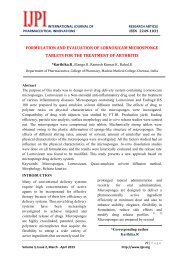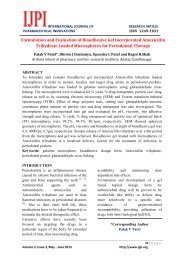Quantitative Estimation of Gallic Acid in Amla Extract by ... - IJPI
Quantitative Estimation of Gallic Acid in Amla Extract by ... - IJPI
Quantitative Estimation of Gallic Acid in Amla Extract by ... - IJPI
You also want an ePaper? Increase the reach of your titles
YUMPU automatically turns print PDFs into web optimized ePapers that Google loves.
INTERNATIONAL JOURNAL OFRESEARCH ARTICLEPHARMACEUTICAL INNOVATIONS ISSN 2249-1031<strong>Quantitative</strong> <strong>Estimation</strong> <strong>of</strong> <strong>Gallic</strong> <strong>Acid</strong> <strong>in</strong> <strong>Amla</strong> <strong>Extract</strong> <strong>by</strong>Gradient RP-HPLC methodAngshuman Biswas 1 , Ananya Chatterjee 2 , Sandip Kumar Bahdhopadhyay 21 Central Drugs Laboratory, 3, Kyd Street, Kolkata-162 Institution <strong>of</strong> Post Graduate Medical Education and Research, A.J.C. Bose Road, KolkataAbstractA Novel RP-HPLC assay method has been developed and validated for the estimation <strong>of</strong>gallic acid. Chromatography was carried on C18 column (250 mm x 4.6 mm I.D., 5 μm) <strong>by</strong>gradient elution utiliz<strong>in</strong>g a mobile phase <strong>of</strong> acetonitrile and water conta<strong>in</strong><strong>in</strong>g 0.01 % v/v orthophosphoric acid (<strong>in</strong> the ratio <strong>of</strong> 80: 20% v/v) with UV detection at wavelength 272 nm at theflow rate 1ml/m<strong>in</strong>. The proposed method was validated for sensitivity, specificity, l<strong>in</strong>earity,accuracy, precision, ruggedness, robustness and solution stability. The response <strong>of</strong> the drugwas l<strong>in</strong>ear <strong>in</strong> the concentration range <strong>of</strong> 5-40 μg/ml. Limit <strong>of</strong> detection and limit <strong>of</strong>quantification was found to be 0.22μg/ml and 6.77μg/ml respectively. The perentagerecovery ranged with<strong>in</strong> 100.01-100.04%. Method, system, <strong>in</strong>terday and <strong>in</strong>traday precisionwere also found to be with<strong>in</strong> the limits <strong>of</strong> acceptance criteria. Method was found to be ruggedwhen analysis was carried out <strong>by</strong> different analyst. The proposed method is rapid, simple andalso it can be applied for the rout<strong>in</strong>e analysis <strong>of</strong> herbal formulations.Keywords: <strong>Gallic</strong> acid, <strong>Amla</strong> Ethanolic extract, RP-HPLC.Introduction<strong>Gallic</strong> acid (GA) is a phenolic compound.Structurally gallic acid has phenolic groupsthat serve as a source <strong>of</strong> readily availablehydrogen atoms such that the subsequentradicals produced can be delocalized overthe phenolic structure 1, 2 . The <strong>in</strong>terest <strong>in</strong>these compounds is due to itspharmacological activity as radicalscavengers 3.4 . It has been proved to havepotential preventive and therapeutic effects<strong>in</strong> many diseases, where the oxidativestress has been implicated, <strong>in</strong>clud<strong>in</strong>gcardiovascular diseases, cancer,neurodegenerative disorders and <strong>in</strong> ag<strong>in</strong>g.Volume 2, Issue 1, January− February 2012The phenolics are also <strong>of</strong> <strong>in</strong>terest <strong>in</strong> food,cosmetic and pharmaceutical <strong>in</strong>dustries, assubstitutes for synthetic antioxidants 5 .Several chromatographic methods havebeen documented for determ<strong>in</strong>ation <strong>of</strong>gallic acid <strong>in</strong> plant extracts 6, 7 but due tothe complex nature and <strong>in</strong>herent variability<strong>of</strong> the chemical constituents <strong>of</strong> the plantbased drugs, it is difficult to establishquality control parameters and hencemodern analytical techniques are expectedto help <strong>in</strong> circumvention this problem. The*Correspond<strong>in</strong>g AuthorAngshuman Biswas72 | P a g ehttp://www.ijpi.org
INTERNATIONAL JOURNAL OFRESEARCH ARTICLEPHARMACEUTICAL INNOVATIONS ISSN 2249-1031objective <strong>of</strong> the present <strong>in</strong>vestigation wasto establish and validate the fast andsensitive high performance liquidchromatography (HPLC) method fordeterm<strong>in</strong>ation <strong>of</strong> gallic acid <strong>in</strong> ethanolicextract <strong>of</strong> amla.ExperimentalApparatusThe HPLC system consisted <strong>of</strong> a solventdelivery module Agilent 1100 SeriesGradient pump equipped with 20 µl loopand G1365B Multi Wavelength Detector.Integration was achieved <strong>by</strong> us<strong>in</strong>g thes<strong>of</strong>tware Chemstation. Separation wascarried out on a Zorbax, (250×4.6mm)5µm C-18 Column.Reagents and materialsEthanolic extract <strong>of</strong> amla, sodiumPhosphate Monobasic, Acetonitrile, OrthoPhosphoric <strong>Acid</strong>, MilliQ water. Allchemicals and solvents used were <strong>of</strong>GR/HPLC grade <strong>of</strong> Rankem, India LimitedChromatographic ConditionThe mobile phase was prepared separatelywith 20mM monobasic Phosphate buffer(mobile phase A) and methanol (mobilephase B) and mobile phase is eluted as perfollow<strong>in</strong>g gradient programm<strong>in</strong>g. The pH<strong>of</strong> the mobile phase (A) is ma<strong>in</strong>ta<strong>in</strong>ed at4.5 with prior correction with 10%phosphoric acid. The prepared buffer wasfiltered through a Millipore 0.45 µmmembrane filter and ultrasonicallydegassed prior to use. Methanol and Water<strong>in</strong> the ratio <strong>of</strong> 2:3 (v/v) was used as diluentthroughout the experiment. The detectionwavelength was set at 272 nm. The elutionwas done at a flow rate <strong>of</strong> 1.0 ml/m<strong>in</strong> underambient condition.Volume 2, Issue 1, January− February 2012Standard Solution and CalibrationCurveA standard stock solution <strong>of</strong> gallic acid(1000 mcg/ml) was prepared <strong>in</strong> diluent.Subsequent dilutions were made <strong>in</strong> diluentto prepare the concentrations2.5,5,10,20,30 and 40 mcg/ml for gallicacid. The calibration curve was done <strong>by</strong>plott<strong>in</strong>g peak area aga<strong>in</strong>st sampleconcentration for each <strong>in</strong>gredient.AssayF<strong>in</strong>ely powdered pure gallic acid wasweighed accurately on the electronicbalance (model Metler Toledo AG285) andvary<strong>in</strong>g concentration <strong>of</strong> the analyte wastaken with proper dilution. The powderequivalent to 64.1 mg <strong>of</strong> ethanolic extractwas weighed accurately and dissolved <strong>in</strong>1.5 ml diluent. The solution was filteredthrough 0.45 µm Millex-HV syr<strong>in</strong>ge drivenmembrane filter unit. Twenty µl <strong>of</strong> thissolution was <strong>in</strong>jected <strong>in</strong> triplicate under thespecified conditions. The peak areasobta<strong>in</strong>ed were related to slopes and<strong>in</strong>tercepts from the calibration data tocalculate concentration <strong>of</strong> the gallic acid <strong>in</strong>ethanolic extract.Results and DiscussionValidation <strong>of</strong> AssayTo validate the developed methodaccuracy, reproducibility and recoveryexperiments were carried out. The recovery<strong>of</strong> the known amount <strong>of</strong> added standardwas studied at three levels. To an aliquot <strong>of</strong>the analyzed formulation a knownconcentration <strong>of</strong> standard solution wasadded. The content <strong>of</strong> gallic acid wasdeterm<strong>in</strong>ed (Table 3).In the present study, a simple, precise,accurate and rapid reverse phase HPLCmethod has been developed and validated73 | P a g ehttp://www.ijpi.org
INTERNATIONAL JOURNAL OFRESEARCH ARTICLEPHARMACEUTICAL INNOVATIONS ISSN 2249-1031for the determ<strong>in</strong>ation <strong>of</strong> gallic acid <strong>in</strong>herbal formulation. The developedanalytical method was validated as per ICHmethod validation guidel<strong>in</strong>es 8 .The validation parameters addressed wereLOD, LOQ, l<strong>in</strong>earity, accuracy, precision,robustness, ruggedness. System suitabilitytests were carried out on freshly preparedstandard stock solutions <strong>of</strong> pure gallic acid(Table 4). The calibration curve was l<strong>in</strong>ear<strong>in</strong> the range <strong>of</strong> 5-40 µg/ml for gallic acid.The limit <strong>of</strong> detection (LOD) and limit <strong>of</strong>quantification (LOQ) for gallic acid wasfound 0.22 µg and 6.77 µg/ml respectively.ConclusionIn the present study, a simple andreproducible method for the estimation <strong>of</strong>gallic acid <strong>in</strong> herbal formulation <strong>by</strong> reversephase HPLC method is developed. Thegallic acid content <strong>in</strong> ethanolic extracttwas quantified. The advantage <strong>of</strong> themethod lies <strong>in</strong> the simplicity <strong>of</strong> the samplepreparation and less run time. Thevalidated parameters <strong>in</strong>dicate that thedeveloped method is quick, highselectivity and economic. Hence thedeveloped method is more suitable for theestimation <strong>of</strong> gallic acid <strong>in</strong> multicomponentherbal formulation.Acknowledgment: Director, CentralDrugs LaboratoryReferences:1. K. Robards , PD Prenzler , G Tucker , PSwatsitang and W Glover. Phenoliccompounds and their role <strong>in</strong> oxidativeprocesses <strong>in</strong> fruits, Food Chem(66)1999401-436.2. KM Nikolic.Theoretical study <strong>of</strong>phenolic antioxidants properties <strong>in</strong>reaction with oxygen-centered radicals,J Mol Struc: THEOCHEM. (774)200695-105.3. M. Karamaæ .,A. Kosiñska andR.B.Pegg , Comparison <strong>of</strong> radical–scaveng<strong>in</strong>g activities <strong>of</strong> selectedphenolic acids.Pol, J. Food Nutr. Sci.(14)2005 165–170.4. S. Kaur , H. Michael , S Arora , P.LHarkonen and S Kumar,The <strong>in</strong> vitrocytotoxic and apoptotic activity <strong>of</strong>Triphala –an Indian herbal drug, J.Ethnopharm. (97)2005 15–20.5. YY. Soong and PJ.Barlow , Antioxidantactivity and phenolic content <strong>of</strong> selectedfruit seeds, Food Chem.(88) 2004 411-417.6. Y. Amakura , M. Okada , S.Tsuji andY. Tonogai, Determ<strong>in</strong>ation <strong>of</strong> phenolicacids <strong>in</strong> fruit juices <strong>by</strong> isocratic columnliquid chromatography, J ChromatogrA. (891) 2000 183-188.7. M. Rizzo , D. Ventrice , MA.Varone ,R. Sidari and A Car<strong>in</strong>i , HPLCdeterm<strong>in</strong>ation <strong>of</strong> phenolics adsorbed onyeasts, JPharm Biomed Anal.(42) 200646-55.8. ICH Harmonized Tripartite Guidel<strong>in</strong>es,Validation <strong>of</strong> Analytical Procedures:Text and Methodology, 1994, Q2R (1).Volume 2, Issue 1, January− February 201274 | P a g ehttp://www.ijpi.org
INTERNATIONAL JOURNAL OFRESEARCH ARTICLEPHARMACEUTICAL INNOVATIONS ISSN 2249-1031Table-1 Gradient programm<strong>in</strong>g <strong>of</strong> HPLC SystemTime (m<strong>in</strong>utes) Mobile phase (A) Mobile phase(B)0 95 58 90 1012 95 5Table-2 Assay <strong>of</strong> <strong>Gallic</strong> acid <strong>in</strong> the ethanolic extract <strong>of</strong> <strong>Amla</strong>Weight <strong>of</strong> Ethanolicextract <strong>of</strong> <strong>Amla</strong> (mg)Amount <strong>of</strong> gallic acid found <strong>in</strong> <strong>Amla</strong><strong>Extract</strong> (%)64.1 0.04465 0.044765.6 0.045Mean 0.0445RSD 1.14Table- 3 Recovery study <strong>of</strong> <strong>Gallic</strong> acid <strong>by</strong> HPLC method<strong>Gallic</strong> acidadded (mg)AmountAmountfound (mg)PercentageRecovery10 20 3010.0045 20.0042 30.0047100.04 100.02 100.01Mean 100.023Volume 2, Issue 1, January− February 201275 | P a g ehttp://www.ijpi.org
INTERNATIONAL JOURNAL OFRESEARCH ARTICLEPHARMACEUTICAL INNOVATIONS ISSN 2249-1031Table-4Parametersresults <strong>of</strong> validation parameters <strong>of</strong> <strong>Gallic</strong> acidL<strong>in</strong>earityL<strong>in</strong>ear equationRangeInterceptCorrelation coefficientResults foundY=19189X+6.205mcg/ml to 40mcg/ml6.200.9901Precision(%RSD)Ruggedness(%RSD)RobustnessLimit <strong>of</strong> Detection (LOD)Limit <strong>of</strong> Quantification (LOQ)System Suitability ParameterCalibration range (mcg/ml)Theoretical PlateTail<strong>in</strong>g Factor0.330.45Robust0.22mcg/ml6.77mcg/ml5mcg/ml to 40mcg/ml40001.2Figure-1 Chromatogram <strong>of</strong> Ethanolic extract <strong>of</strong> <strong>Gallic</strong> acidVolume 2, Issue 1, January− February 201276 | P a g ehttp://www.ijpi.org
















